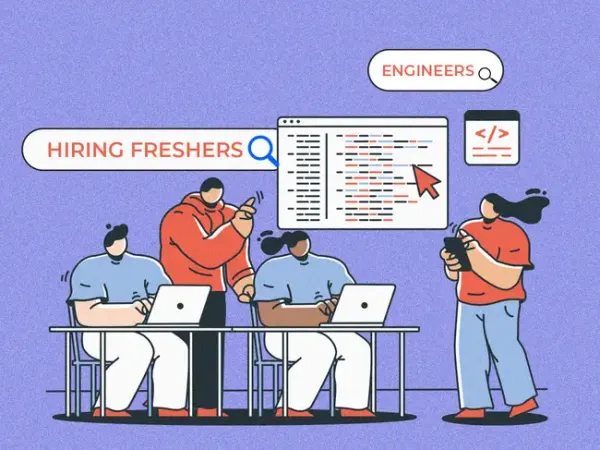If payroll additions are considered the ideal barometer of health for the $283-billion Indian outsourcing industry, the June quarter has been far from ideal.
Job additions at the top six IT majors stood at just 3,847 in April-June, a drop of almost 72% from 13,935 people who were hired by the six firms in the March quarter, the latest earnings statements showed.
Among the largest software service providers, only two including the top two leaders Tata Consultancy Services (TCS) and Infosys reported an increase in workforce by 5060 and 210 people between April and June. The remaining four - HCLTech, Wipro, TechM and LTIMindtree - witnessed a cumulative dip of 1,423 people.
While this comes at a time when the outsourcing industry is struggling to grow revenue, which is typically in proportion to employee growth, AI-led efficiency is seen as one of the key reasons for helping IT vendors get tech work done with fewer employees.
“The current stagnancy in headcount additions potentially reflects a strategic recalibration. This shift is driven by the widespread adoption of AI, automation and cloud-based architectures, which have significantly reshaped hiring trends across the IT industry,” said Milind Shah, managing director at recruitment firm Randstad Digital India.
Experts say that the people-led $283-plus billion revenue-sized IT sector is also undergoing de-linearity in the revenue growth vis-à-vis the talent addition due to AI resulting in the hiring landscape transitioning towards a focus on efficiency, innovation, and strategic workforce planning. With AI-driven automation reshaping business models, companies must prioritize digital transformation, employee upskilling, and advanced hiring strategies.
“As conventional roles evolve, hiring has become more selective and aligned with core business objectives. Simultaneously, organisations are transforming workforce strategies by redeploying existing talent through upskilling programs and capability development rather than expanding workforce numbers,” Shah added.
Foot in the Door
Meanwhile, generic entry-level hiring, that formed a majority of the pyramid-model mass workforce at the IT firms, has fallen by as much as 50% compared to pre-pandemic years, staffing firm Teamlease data showed.
“While early indicators for FY26 suggest a cautious rebound—with top IT firms projecting higher fresher intake linked to increase in the number of projects coming to India, hiring will remain skill-driven and unlikely to return to earlier volumes,” said Neeti Sharma, CEO of Teamlease Digital.
LTIMindtree chief Venugopal Lambu told ET after the Q1FY26 results, “Over the last few quarters, when we added revenue, the headcount has not necessarily increased. So, there is a correlation or a non-linearity, but it is too early to call out to what extent it will happen.”
On the flip side, the first half (H1) of the ongoing calendar year 2025 (CY2025) – January to June – showed a net positive headcount movement for the first time in the last three years.
The previous H1s of CY2024 and CY2023 had net negative movement of talent growth in the top six IT companies with a decline of 14,000 and 32,000, respectively.
“This cohort of Tier-1 IT service players have had challenges with headcount additions since the latter half of CY2022, when the post-lockdown hyper hiring phase ended and sectoral headwinds hit hiring plans. As the cohort continues to tackle gradually rising attrition rates, a positive net headcount growth is a sign of a recovery in play,” said Kamal Karanth, cofounder at another recruitment firm Xpheno.
Karanth was quick to add that these are also early signs, and we will have to wait for the second half to see if the growth trajectory is sustained.
While all the companies have spelt out stronger fresher hiring plans, they continue to recalibrate the lateral hiring based on the demand outlook, which continues to remain uncertain led by the tariff situation and cautious spending by clients.
Collectively, the six software service providers employ around 16.25 lakh people, which is still below 16.58 lakh seen at the end of June 2022.
Job additions at the top six IT majors stood at just 3,847 in April-June, a drop of almost 72% from 13,935 people who were hired by the six firms in the March quarter, the latest earnings statements showed.
Among the largest software service providers, only two including the top two leaders Tata Consultancy Services (TCS) and Infosys reported an increase in workforce by 5060 and 210 people between April and June. The remaining four - HCLTech, Wipro, TechM and LTIMindtree - witnessed a cumulative dip of 1,423 people.
While this comes at a time when the outsourcing industry is struggling to grow revenue, which is typically in proportion to employee growth, AI-led efficiency is seen as one of the key reasons for helping IT vendors get tech work done with fewer employees.
“The current stagnancy in headcount additions potentially reflects a strategic recalibration. This shift is driven by the widespread adoption of AI, automation and cloud-based architectures, which have significantly reshaped hiring trends across the IT industry,” said Milind Shah, managing director at recruitment firm Randstad Digital India.
Experts say that the people-led $283-plus billion revenue-sized IT sector is also undergoing de-linearity in the revenue growth vis-à-vis the talent addition due to AI resulting in the hiring landscape transitioning towards a focus on efficiency, innovation, and strategic workforce planning. With AI-driven automation reshaping business models, companies must prioritize digital transformation, employee upskilling, and advanced hiring strategies.
“As conventional roles evolve, hiring has become more selective and aligned with core business objectives. Simultaneously, organisations are transforming workforce strategies by redeploying existing talent through upskilling programs and capability development rather than expanding workforce numbers,” Shah added.
Foot in the Door
Meanwhile, generic entry-level hiring, that formed a majority of the pyramid-model mass workforce at the IT firms, has fallen by as much as 50% compared to pre-pandemic years, staffing firm Teamlease data showed.
“While early indicators for FY26 suggest a cautious rebound—with top IT firms projecting higher fresher intake linked to increase in the number of projects coming to India, hiring will remain skill-driven and unlikely to return to earlier volumes,” said Neeti Sharma, CEO of Teamlease Digital.
LTIMindtree chief Venugopal Lambu told ET after the Q1FY26 results, “Over the last few quarters, when we added revenue, the headcount has not necessarily increased. So, there is a correlation or a non-linearity, but it is too early to call out to what extent it will happen.”
On the flip side, the first half (H1) of the ongoing calendar year 2025 (CY2025) – January to June – showed a net positive headcount movement for the first time in the last three years.
The previous H1s of CY2024 and CY2023 had net negative movement of talent growth in the top six IT companies with a decline of 14,000 and 32,000, respectively.
“This cohort of Tier-1 IT service players have had challenges with headcount additions since the latter half of CY2022, when the post-lockdown hyper hiring phase ended and sectoral headwinds hit hiring plans. As the cohort continues to tackle gradually rising attrition rates, a positive net headcount growth is a sign of a recovery in play,” said Kamal Karanth, cofounder at another recruitment firm Xpheno.
Karanth was quick to add that these are also early signs, and we will have to wait for the second half to see if the growth trajectory is sustained.
While all the companies have spelt out stronger fresher hiring plans, they continue to recalibrate the lateral hiring based on the demand outlook, which continues to remain uncertain led by the tariff situation and cautious spending by clients.
Collectively, the six software service providers employ around 16.25 lakh people, which is still below 16.58 lakh seen at the end of June 2022.








